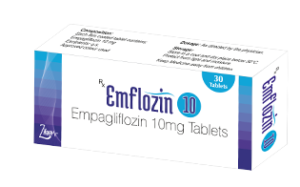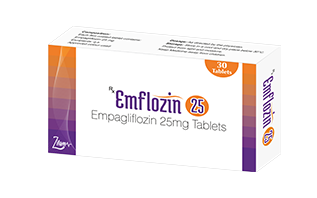Emflozin 10/25
- ENG
- မြန်မာ

Composition:
Each film coated tablet contains:
Empagliflozin 10 mg
Approved colour used q.s

Composition:
Each film coated tablet contains:
Empagliflozin 25 mg
Approved colour used q.s
Pharmacological action:
Empagliflozin is a reversible, highly potent (IC50 of 1.3 nmol) and selective competitive inhibitor of sodium glucose co-transporter 2 (SGLT2). Empagliflozin does not inhibit other glucose transporters important for glucose transport into peripheral tissues and is 5000 times more selective for SGLT2 versus SGLT1, the major transporter responsible for glucose absorption in the gut.[/more]
Empagliflozin improves glycaemic control in patients with type 2 diabetes by reducing renal glucose reabsorption. In addition, initiation of empagliflozin increases excretion of sodium resulting in osmotic diuresis and reduced intravascular volume.
In patients with type 2 diabetes, urinary glucose excretion increased immediately following the first dose of empagliflozin and is continuous over the 24-hour dosing interval. Increased urinary glucose excretion resulted in an immediate reduction in plasma glucose levels in patients with type 2 diabetes.
Empagliflozin improves both fasting and post-prandial plasma glucose levels. The mechanism of action of empagliflozin is independent of beta-cell function and insulin pathway and this contributes to a low risk of hypoglycaemia. The glucosuria observed with empagliflozin is accompanied by diuresis which may contribute to sustained and moderate reduction of blood pressure. The glucosuria, natriuresis and osmotic diuresis observed with empagliflozin may contribute to the improvement in cardiovascular outcomes.[/more]
Therapeutic category:
Oral antidiabetic drug
Therapeutic Indications:
EMFLOZIN is indicated for the treatment of adults with insufficiently controlled type 2 diabetes mellitus as an adjunct to diet and exercise:
- as monotherapy when metformin is considered inappropriate due to intolerance
- In addition to other medicinal products for the treatment of diabetes
Posology and administration:
Posology
The recommended starting dose is 10 mg empagliflozin once daily for monotherapy and add-on combination therapy with other medicinal products for the treatment of diabetes. In patients tolerating empagliflozin 10 mg once daily who have an eGFR ≥ 60 ml/min/1.73 m2 and need tighter glycaemic control, the dose can be increased to 25 mg once daily.[/more]
The maximum daily dose is 25 mg.
When empagliflozin is used in combination with a sulphonylurea or with insulin, a lower dose of the sulphonylurea or insulin may be considered to reduce the risk of hypoglycaemia.[/more]
Special populations
Renal impairment: Due to the mechanism of action, the glycaemic efficacy of empagliflozin is dependent on renal function. No dose adjustment is required for patients with an eGFR ≥ 60 ml/min/1.73 m2 or CrCI ≥ 60 ml/min. Empagliflozin should not be initiated in patients with an eGFR <60 ml/min/1.73 m2 or CrCI <60 ml/min. In patients tolerating empagliflozin whose eGFR falls persistently below 60 ml/min/1.73 m2 or CrCI below 60 ml/min, the dose of empagliflozin should be adjusted to or maintained at 10 mg once daily. Empagliftozin should be discontinued when eGFR is persistently below 45 ml/min/1.73 m2 or CrCI persistently below 45 ml/min.[/more]
Empagliflozin should not be used in patients with end-stage renal disease (ESRD) or in patients on dialysis as it is not expected to be effective in these patients.
Hepatic impairment: No dose adjustment is required for patients with hepatic impairment. Empagliflozin exposure is increased in patients with severe hepatic impairment. Therapeutic experience in patients with severe hepatic impairment is limited and therefore not recommended for use in this population.
Elderly: No dose adjustment is recommended based on age. In patients 75 years and older, an increased risk for volume depletion should be taken into account. In patients aged 85 years and older, initiation of empagliflozin therapy is not recommended due to the limited therapeutic experience.
Paediatric population: The safety and efficacy of empagliflozin in children and adolescents has not yet be an established. No data are available.
Method of administration: The tablets can be taken with or without food, swallowed whole with water. If a dose is missed, it should be taken as soon as the patient remembers. A double dose should not be taken on the same day.[/more]
Contraindications:
EMFLOZIN is contraindicated in patients known for hypersensitivity to the active substance or to any of the excipients.
Warnings and Precautions:
Empagliflozin should not be used in patients with type 1 diabetes or for the treatment of diabetic ketoacidosis (DKA). The safety and efficacy of empagliflozin in patients with type 1diabetes have not been established and empagliflozin should not be used for the treatment of patients with type 1diabetes. Limited data from clinical trials suggest that DKA occurs with common frequency when patients with type 1 diabetes are treated with SGLT2 inhibitors.[/more]
Renal Impairment: Due to the mechanism of action, the glycaemic efficacy of empagliflozin is dependent on renal function. Therefore assessment of renal function is recommended as follows:
- Prior to empagliflozin initiation and periodically during treatment, i.e. at least yearly.
- Prior to initiation of any concomitant medicinal product that may have a negative impact on renal function.
Cases of hepatic injury have been reported with empagliflozin in clinical trials. A causal relationship between empagliflozin and hepatic Injury has not been established.
Haematocrit increase was observed with empagliflozin treatment.
The effect of empagliflozin on urinary glucose excretion is associated with osmotic diuresis, which could affect the hydration status. Patients aged 75 years and older may be at an increased risk of volume depletion. Special attention should be given to their volume intake in case of co-administered medicinal products which may lead to volume depletion (e.g. diuretics, ACE-inhibitors).
Caution should be exercised in patients for whom an empagliflozin-induced drop in blood pressure could pose a risk, such as patients with known cardiovascular disease, and patients on anti-hypertensive therapy with a history of hypotension or patients aged 75 years and older.
In case of conditions that may lead to fluid loss (e.g. gastrointestinal illness), careful monitoring of volume status (e.g. physical examination, blood pressure measurements, laboratory tests including haematocrit) and electrolytes is recommended for patients receiving empagliflozin. Temporary interruption of treatment with empagliflozin should be considered until the fluid loss is corrected.
Complicated urinary tract infections (including serious urinary tract infections, pyelonephritis or urosepsis) occurred at a similar frequency in patients treated with empagliflozin compared to placebo. However, temporary interruption of empagliflozin should be considered in patients with complicated urinary tract infections.
An increase in cases of lower limb amputation (primarily of the toe) has been observed in ongoing long-term clinical studies with another SGLT2 Inhibitor. It is unknown whether this constitutes a class effect. Like for all diabetic patients, it is important to counsel patients on routine preventative foot-care.
Due to its mechanism of action, patients taking empagliflozin will test positive for glucose in their urine.[/more]
Pregnancy and Lactation: There are no data from the use of empagliflozin in pregnant women. Animal studies show that empagliflozin crosses the placenta during late gestation to a very limited extent but does not indicate direct or indirect harmful effects with respect to early embryonic development. [/more]However, animal studies have shown adverse effects on postnatal development. As a precautionary measure, it is preferable to avoid the use of Empagliflozin during pregnancy.
No data in humans are available on excretion of empagliflozin into milk. Available toxicological data in animals have shown excretion of empagliflozin in milk. A risk to the newborns/Infants cannot be excluded. Empagliflozin should not be used during breast-feeding.[/more]
Warning: Cases of a rare but serious infection of the genitals and area around the genitals have been reported with this class of type 2 diabetes medicines i.e. Sodium-Glucose Cotransporter-2 (SGLT-2) inhibitors. This serious rare infection, called necrotizing fascilitis of the perineum, is also referred to as Fournier’s gangrene.
Adverse effects:
The adverse reactions associated with the use of Empagliftozin include:
- Hypotension
- Ketoacidosis
- Acute Kidney Injury and Impairment in Renal Function
- Urosepsis and Pyelonephritis
- Hypoglycemia with Concomitant Use with Insulin and Insulin Secretagogues
- Genital Mycotic Infections
- Increased Low-Density Lipoprotein Cholesterol (LDL-C)
Drug Interaction
Empagliflozin may add to the diuretic effect of thiazide and loop diuretics and may increase the risk of dehydration and hypotension. Insulin and insulin secretagogues, such as sulphonylureas, may increase the risk of hypoglycaemia. Therefore, a lower dose of insulin or insulin secretagogues may be required to reduce the risk of hypoglycaemia when used in combination with empagliflozin.[/more]
Monitoring glycemic control with urine glucose tests is not recommended in patients taking SGLT2 inhibitors as SGLT2 inhibitors increase urinary glucose excretion and will lead to positive urine glucose tests. Use alternative methods to monitor glycemic control.
Co-medication with known inducers of UGT enzymes should be avoided due to a potential risk of decreased efficacy.
Empagliflozin does not inhibit human uptake transporters such as OAT3, OATP1B1, and OATP1B3 in vitro at clinically relevant plasma concentrations and, as such, drug-drug interactions with substrates of these uptake transporters and considered unlikely.
No dose adjustments of Empagliftozin were necessary when it was co-administered with gemfibrozil, rifampicin, or probenecid.
Empagliflozin exposure was similar with and without co-administration with verapamil, a P-gp inhibitor, indicating that inhibition of P-gp does not have any clinically relevant effect on empagliflozin.
Interaction studies suggest that the pharmacokinetics of empagliflozin were not influenced by co-administration with metformin, glimepiride, pioglitazone, sitagliptin, linagliptin, warfarin, verapamil, ramipril, simvastatin, torasemide, hydrochlorothiazide and oral contraceptives.[/more]
Overdosage:
Symptoms
In controlled clinical studies, single doses of up to 800 mg empagliflozin (equivalent to 32 times the highest recommended daily dose) in healthy volunteers and multiple daily doses of up to 100 mg empagliflozin (equivalent to 4 times the highest recommended daily dose) in patients with type 2 diabetes did not show any toxicity. Empagliflozin increased urine glucose excretion leading to an increase in urine volume. The observed increase in urine volume was not dose-dependent and is not clinically meaningful. There is no experience with doses above 800 mg in humans.
Therapy
In the event of an overdose, treatment should be initiated as appropriate to the patient’s clinical status. The removal of empagliflozin by haemodialysis has not been studied.
Pharmacological Information:
Storage conditions:
Store in a cool and dry place below 30•C.
Protect from light and moisture.
Keep medicine away from children.
Shelf Life: 36months
Pack size: Blister pack of 10 tablets
Updated on 9/Feb /2024





